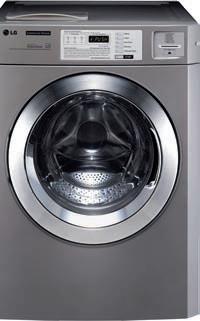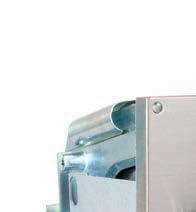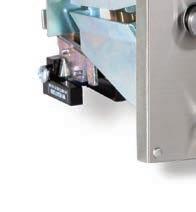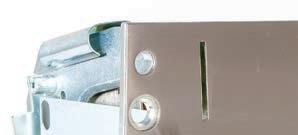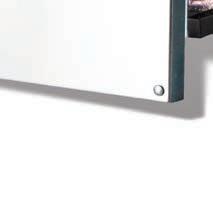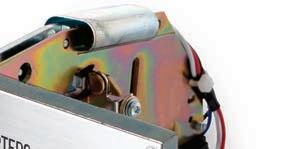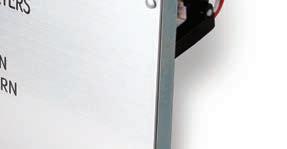































































































Coin-operated laundry equipment has been the standard for years but the use of digital, cashless payment continues to surge as consumers become entrenched in its conveniences. But what’s involved in converting a coin-based operation to one whose payment acceptance is based on credit/debit/store value card or a digital wallet?







What do you think it would take to enter the commercial linen and uniform rental market? There are streams of potential new revenue available there, yes, but also some new operational challenges and maybe some headaches. During the Clean Show this summer, three operators—including one multi-store laundromat owner—described how they made entry and what they learned from the experience.

Any number of vended laundry projects, either new construction or rebuilds/retools, are completed around the United States each year and 2022 was no different.
In recognition of the hard work that goes into designing, building and equipping a modern self-service laundry, beginning on page 6, American Coin-Op takes a brief look at some memorable projects of recent vintage in “Portraits of Success.”
The snapshots of laundry businesses in Indiana, New York, Iowa, Utah and Massachusetts depict just a small sampling of stores whose owners have invested in their communities and staked their claim to a piece of the billion-dollar vended laundry industry.
This month’s other main feature is titled “Converting a Coin Store to Offer Cashless Payment.” With the help of representatives from several companies that offer payment systems to laundromats, we examine the basics involved in embracing card or mobile payment options: making preparations for a conversion, how long such a project might take, comparing partial conversion to complete conversion, and more. That story begins on page 18.
The end of the year is always a natural time for reflection. For us here at American Coin-Op, 2022 marked our publication’s 62nd year of service to the industry.
In addition to our printed magazine and digital edition, we’re proud to bring you our website, AmericanCoinOp.com; our twicea-week enewsletter, The Wire; and our every-other-month podcast.
If there’s an interesting and informative self-service laundry story out there, we’re eager to tell it. We look forward to doing more of the same in 2023.
On behalf of the staff at American Trade Magazines, I wish you and yours Happy Holidays and a prosperous New Year.
Bruce Beggs Editorial DirectorCharles Thompson, Publisher
E-mail: cthompson@ATMags.com Phone: 312-361-1680
Donald Feinstein, Associate Publisher/ National Sales Director
E-mail: dfeinstein@ATMags.com Phone: 312-361-1682

Bruce Beggs, Editorial Director
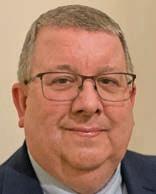
E-mail: bbeggs@ATMags.com Phone: 312-361-1683
Mathew Pawlak, Production Manager
Nathan Frerichs, Digital Media Director
E-mail: nfrerichs@ATMags.com Phone: 312-361-1681

Andy Wray
Main: 312-361-1700
American Coin-Op (ISSN 0092-2811) is published monthly. Subscription prices, payment in advance: U.S., 1 year $50.00; 2 years $100.00. Single copies $10.00 for U.S. Published by American Trade Magazines LLC, 650 West Lake Street, Suite 320, Chicago, IL 60661. Periodicals postage paid at Chicago, IL and at additional mailing offices.
POSTMASTER, Send changes of address and form 3579 to American Coin-Op, Subscription Dept., 125 Schelter Rd., #350, Lincolnshire, IL 60069-3666. Volume 63, number 12. Editorial, executive and advertising offices are at 650 West Lake Street, Suite 320, Chicago, IL 60661. Charles Thompson, President and Publisher. American Coin-Op is distributed selectively to owners, operators and managers of chain and individually owned coin-operated laundry establishments in the United States. The publisher reserves the right to reject any advertising for any reason.
© Copyright AMERICAN TRADE MAGAZINES LLC, 2022. Printed in U.S.A. No part of this publication may be transmitted or reproduced in any form, electronic or mechanical, without written permission from the publisher or his representative. American Coin-Op does not endorse, recommend or guarantee any article, product, service or information found within. Opinions expressed are those of the writers and do not necessarily reflect the views of American Coin-Op or its staff. While precautions have been taken to ensure the accuracy of the magazine’s contents at time of publication, neither the editors, publishers nor its agents can accept responsibility for damages or injury which may arise therefrom.

Anumber of vended laundry projects are completed around the country each year, resulting in brand-new or rejuvenated stores primed and ready to serve customers. As a way to celebrate the hard work that goes into designing, building and equipping a modern self-service laundry,
American Coin-Op created this Portraits of Success feature to recognize memorable projects of recent vintage.
And so equipment manufacturers were invited to tout their brand’s latest and greatest vended laundry projects. These are the stories that they shared.





Can a laundromat inspire not only customers but jump-start a neighborhood? That was Tracey and Renee Gillis’ hope when they opened Big Bubbles in East Chicago, Indiana.
“You can’t reinvent it, but you can make the wheel look better,” Tracey says of the couple’s new take on the laundromat business, which features Speed Queen Quantum Touchcontrolled washer-extractors and tumblers.








Once inside Big Bubbles’ front door (A), customers will find a clearly branded, clean, brightly lit laundromat that makes good use of its space (B). Speed Queen Quantum Touch-controlled washer-extractors and tumblers stand at the ready, as do attractive yet functional folding areas (C). Once the laundry’s in, House of Gamez (D), another business owned by the Gillises, offers plenty of games to pass the time until the cycle is done. (Photos: Alliance Laundry Systems)










Make no mistake, the Gillises took the concept further than the self-service and washdry-fold elements they offer. With their House of Gamez business featuring classic stand-up arcade games, game systems, pool, and darts next door, they’re not just making good use of the space afforded them by the former furniture store; they’re giving customers much more.



And then there’s the inspiration. When you give customers a memorable experience, not only do they come back, they treat it like its their own. Scarcely is there anything on the floor for more than a second or two; the owners say their store is immaculate. The Gillises are quick to point out that they want customers to feel at home. They even spend extra time and resources decorating the laundry for the holidays. But that’s just part of the story.






arcade games, game systems, pool, and


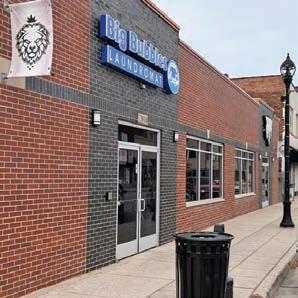
the former furniture store; they’re giving of this year, features a wide range of 60- and 80-pound units, as well as 30-
Since opening, two additional restaurants have set up shop just down the street. An ice cream/candy store is coming soon just across the way. The couple is excited that their example — doing this at the highest level — is inspiring even more neighborhood investment.
“That’s what business is about,” Tracey says of lifting up others. And by all accounts, Big Bubbles and its neighborhood jump-start have big futures. Already, Tracey and Renee have their sights set on expansion and continuing to reimagine the laundromat “wheel” in the years ahead.
availability, end-of-cycle alerts, and cashless
Big Bubbles, which opened in July of this year, features a wide range of washer-extractor capacities to fit a customer’s needs, including 20-, 30-, 40-, 60- and 80-pound units, as well as 30and 45-pound stack tumble dryers. The Speed Queen App gives customers a variety of tools, such as checking machine availability, end-of-cycle alerts, and cashless payment abilities.

As an architect and general contractor, Tracey took the lead in designing the store and used his own crews to do the work. Despite the scope of work, including electrical and plumbing upgrades, in addition to the buildout, the result was a streamlined ninemonth process from purchasing the building to opening. When it came to equipment,
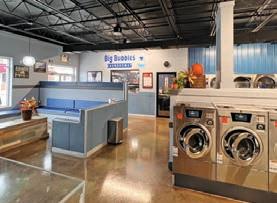





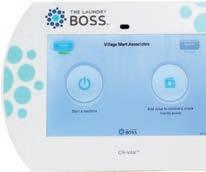

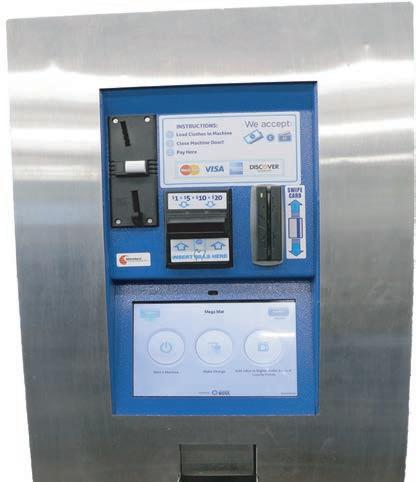

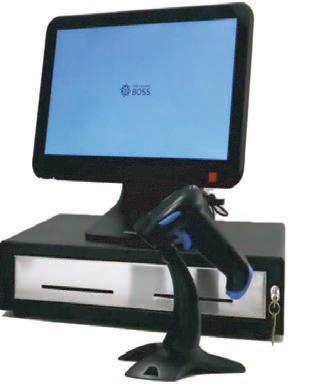



Superior Laundry Center, Brooklyn, New York, is the newest store operated by Superior Laundry Equipment, a commercial/industrial laundry equipment sales and service company. It opened in November 2021.


Led by President Michael Gekelman, Superior Laundry Center is a 6,000-squarefoot attended facility divided between 4,000 square feet of laundry space and 2,000 square feet of parking for customers. It’s open seven days a week and offers self-service, same-day wash/dry/fold, dry cleaning, and leather, suede and fur cleaning.
The new construction build originated as just a “warehouse with empty walls,” according to Gekelman. Superior Laundry Equipment found the space, ran a demographics report, created a pro forma and negotiated a long-term lease. Additionally, it assisted with financing; hired an architect, engineer and interior designer; prepared the store’s layout and design; and recommended a general contractor to build the store.
Superior Laundry Equipment Co. was in charge of the entire project, and the new store was completed in eight months at a cost of $1.2 million.


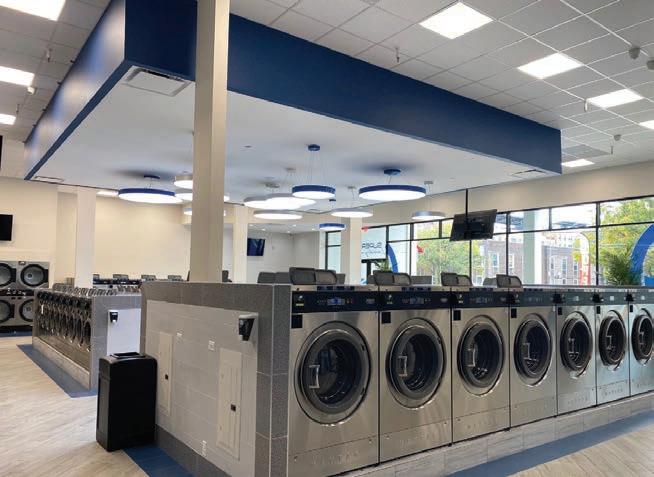

Superior bought and installed the newest line of Maytag® Commercial Laundry multi-load washers and ADC dryers to provide consumers everything they would need when washing and drying their personal items. There are 53 washers (19 20-pounders, 16 30-pounders, seven 40-pounders, seven 55-pounders and four 65-pounders) and 56 dryer pockets (20 30-pound stacks and eight 45-pound stacks)









Among the other equipment and fixtures in use are a Laundroworks card system, Arbelsoft POS system, CAS scale, Triad bill breaker, Vend-Rite soap vending machine, Federal Machine soda/snack vending machine, R&B Wire Products anti-bacterial laundry carts, Navien water heater, Knight chemical dispensing and Sol-O-Matic tables.

Gekelman says the store’s technology allows registered customers to find available machines and check on load status.
Several different cycles available on the washers enables customers to select what option works best for them based on their needs and budget.
In marking its first anniversary last month, Superior Laundry Center took pride in its safe, clean and friendly environment for customers and employees. Additionally, the innovative and intricate store design attracts customers from different neighborhoods to visit and discover what the business has to offer.
Superior Laundry Equipment and Maytag Commercial Laundry have worked together for more than 20 years, and Maytag recently recognized Superior with a Vended Excellence Award for North America.
Birthed from a “warehouse with empty walls,” Superior Laundry Center offers a safe, clean and friendly environment (A) for its customers and employees, owners say. Its innovative and intricate store design (B and C) attracts customers from other neighborhoods to visit and learn what the business has to offer. And for those lucky enough to grab it, there’s some covered parking up front.
(Photos: Maytag® Commercial Laundry)


First-time store owners Perry and Kim Daugherty opened the doors at FreshXpress Laundromat in August 2021 and their business has been delighting customers in and around Centerville, Iowa, roughly 85 miles southeast of Des Moines, ever since.

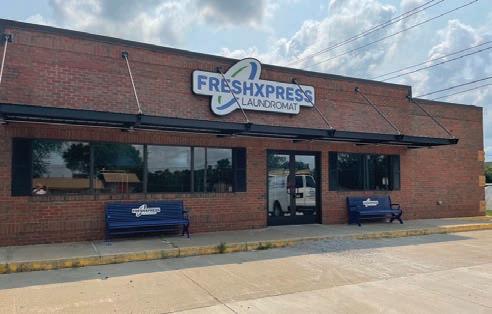




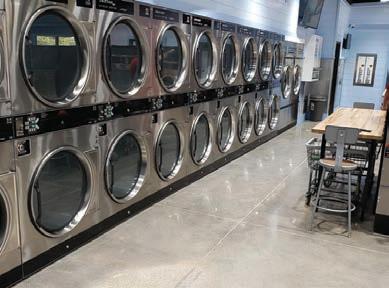







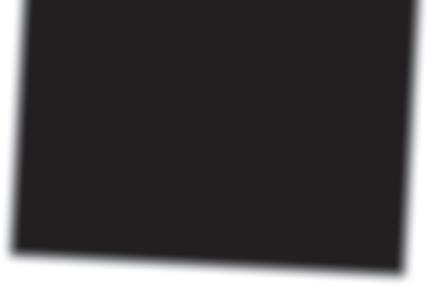



At 2,800 square feet, FreshXpress is a selfservice laundromat that’s open 24 hours a day and offers a wash/dry/fold service. Occupying a former convenience store, the laundry has been a great addition to the rural community.
Century Laundry Distributing, a Dexter authorized distributor, was a key partner in providing the Daughertys with the necessary tools and resources in pinpointing a location, determining the right product mix, financing, and installing the equipment.
Sales representative Joel Schulte led the first-time owners/operators—Perry is a farmer and Kim an elementary school teacher— every step of the way, including setting up a DexterLive and DexterPay system.
The Dexter Laundry Express washers offered for use at FreshXpress include four 20-pound T-350 units, six 30-pound T-450s,
six 40-pound T-650s, four 60-pound T-950s and two 90-pound T-1450s.
Complementing them are 22 Dexter Laundry Express dryer pockets—10 T-50x2 stacks (100 pounds per unit) and two T-80s (80 pounds each)—offering a total capacity of 1,160 pounds.
The couple served as their own general contractor, and the project—site selection, site inspection, plan development, demolition, construction, final installation, and opening—took nearly six months to complete.
Not including the purchase of real estate, the FreshXpress project cost roughly $625,000 for equipment and construction.
The COVID-19 pandemic forced businesses, as well as individuals, to do plenty of adjusting, course correcting, and some flat-out reinventing. Steven Chadwick is pretty happy that the Oasis team decided to adapt its original idea for a strictly commercial laundry to support another need: a dual-purpose laundromat.
While Oasis Laundromat in American Fork, Utah, may be used for commercial work in the evenings, customers are treated to a daytime experience that beats anything they’ve seen, according to Chadwick, one of its owners. Convenience reigns supreme in the 3,000-square-foot facility that opened in May 2021.
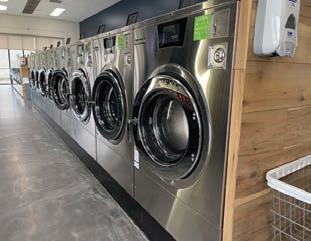
“Our goal was to create a laundry space that we didn’t see [in the area],” he says. “To build a space that felt like home.”
Since it opened, customers have been flocking to the laundry, located between Salt Lake City and Provo along the Wasatch Range, for a differentiated experience featuring Huebsch Galaxy Touch controls. The laundry offers 23 40-pound washer-extractors, nine 60s and, for those big loads, six 80-pounders. The dry side features 45-pound stacks and five 75-pounders.




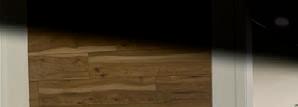



Rhino Laundry and Dry Cleaning Specialists of Salt Lake City took the lead on a significant portion of the install work and has been instrumental in after-sale support with the Huebsch technology.



While some laundromats like to tout convenience, Oasis takes it to the next level. Customers can leave those heavy, awkward laundry chemical jugs at home. Tapping the flexibility of the machines and controls, the team decided to offer customers the option of automatic detergent and softener. Roughly 25% of customers select the cycle modifier.
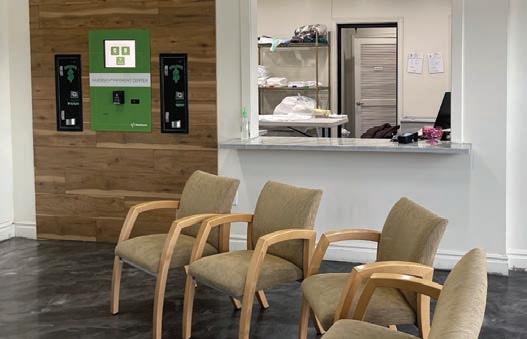


The laundry also offers drycleaning drop-off, wash/dry/fold (WDF) service, Wi-Fi, fountain drinks, vending, massage chairs, and charging stations. Chadwick and the entire Oasis

A
team have been exceptionally pleased with the growth of the commercial account business, which includes nursing homes and Airbnbs.
Staff is obviously central to processing WDF loads, and Chadwick says the team has been committed to keeping the store fully staffed to provide excellent customer care from the moment they walk through the door.
“It’s a night and day difference,” he says of the retool of the former run-down laundry and the focus on customer service. “They’ve never seen a laundromat like ours.”
Customers are embracing the convenience of the Huebsch App and the app-based payment, with adoption estimated to be 70-90%.
So, what’s next? Expansion, of course. The Oasis team is looking forward to adding multiple locations over the next 10 years.
Besides its high-tech laundry equipment featuring Huebsch Galaxy Touch controls (A and C), Oasis Laundromat offers drycleaning drop-off, WDF service, fountain drinks, vending, massage chairs and charging stations. The Huebsch Payment Center and two changers are easy to locate along one wall (B). “Our goal was to create a laundry space that we didn’t see [in the area],” owner Steven Chadwick says of Oasis. (Photos: Alliance Laundry Systems)
There’s more: We’re just two members of NIE’s team of experts. NIE has been handling fabricare insurance since 1915!
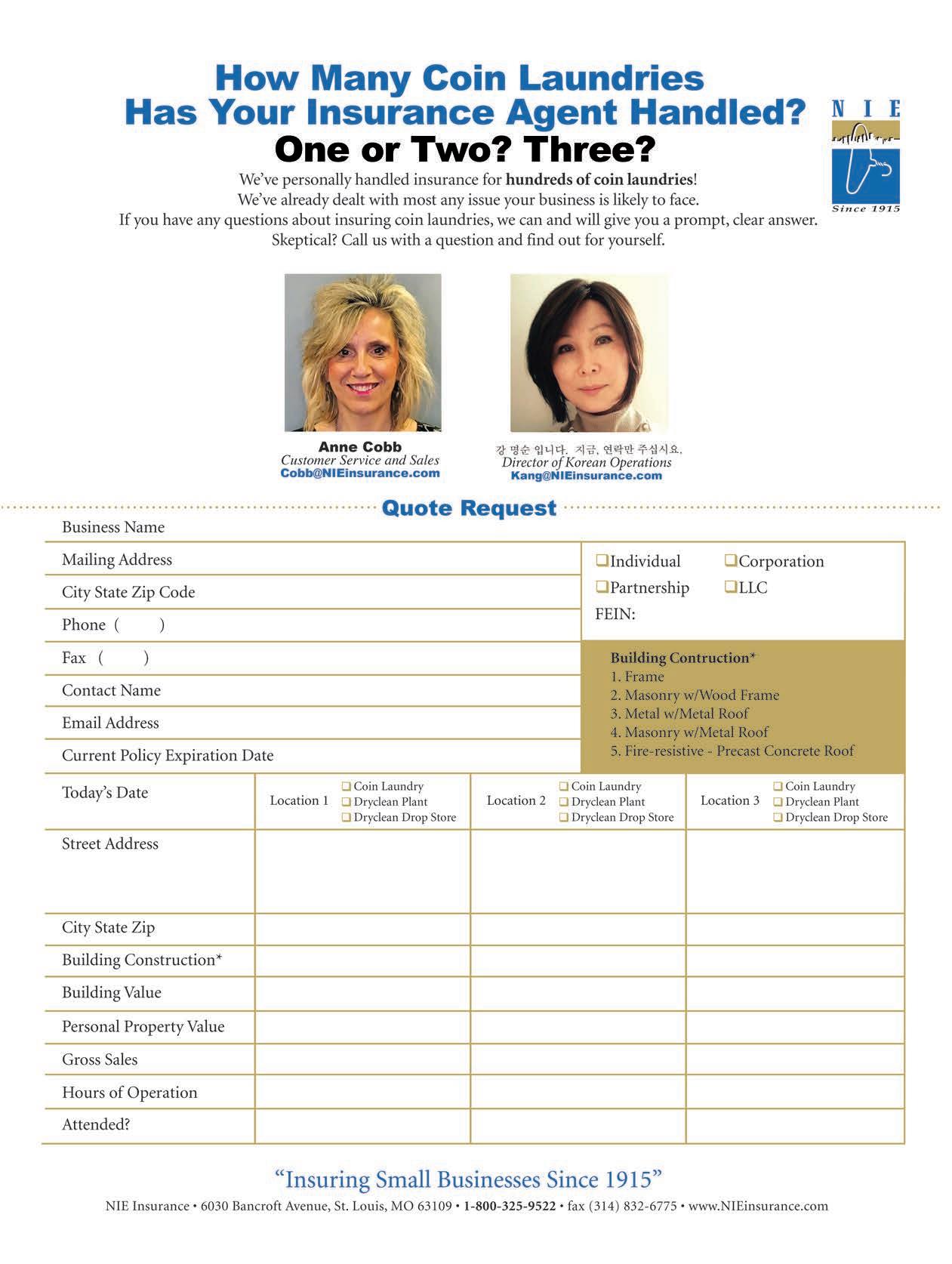
Jeb Balise built his brand and reputation on customer convenience, express service and community value. And the owner of multiple car washes and a large auto dealership group is comfortable chasing opportunity. He found himself asking, “Why couldn’t I be a laundry operator?” In the span of a year, he became one.
Love Your Laundry in Hyannis, Massachusetts, is a high-speed laundry designed to outshine the competition and give back to its community. Balise’s 3,500-square-foot store opened in September 2021.


Developed with help from Daniels Equipment Co. in Auburn, New Hampshire, it showcases Continental high-speed ExpressWash® Washers and ExpressDry® Dryers; a San-O3Wash ozone sanitization system; a Family Read, Play & Learn literacy space; drop-off wash/dry/fold (WDF) service; and the Card Concepts Inc. FLEX payment system.
“The Daniels team went above and beyond to help us understand the laundry business,” says Balise. “Their level of service is phenomenal, and their insight into the market helped us maximize this opportunity.”
Daniels ran demographic studies, pro formas, and competitive analyses on this store and another that Balise developed in Springfield. “Both spots offer great visibility and a high density of renters,” says Daniels Sales Consultant Tim Avallone.


Love Your Laundry showcases an equipment mix of high-speed, soft-mount washers in 20- to 130-pound capacities. They improve customer turnover, cut laundry processing time and reduce utility costs for more profit per square foot, says Avallone. The 13-load mega machines work to attract customers with large families and bulky loads.
The soft-mount washers generate extract speeds reaching 400-plus G-force when compared with hard-mount washers that produce 75-200 G-force, according to Avallone. By comparison, ExpressWash soft-mount machines cut resulting dry time by up to 50%, reducing


natural gas and electricity usage for lower overhead costs.

“Our high-speed washers and dryers really set us apart from our competition,” says Love Your Laundry General Manager Tony DeBarros, “by enabling customers to get in and out in under an hour and allowing us to serve more customers per day.”

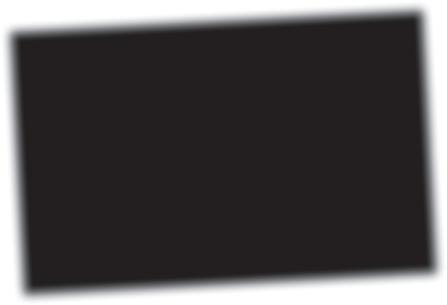
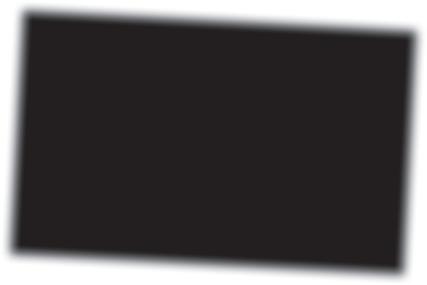
The ozone system is designed to kill 99.9% of bacteria, viruses and molds in customers’ laundry by automatically injecting environmentally friendly ozone into every washer. “The sanitization makes the store smell fresh and clean,” Balise says. “Customers get educated in our store and it’s a happy surprise and value point of sale that locks them in.”
The payment system allows customers to use a loyalty card, mobile app or debit/credit card to operate machines. Meanwhile, there are multiple store-management capabilities, including programming machines, running promotional specials, altering vend pricing, and tracking everything from daily revenue to average turns.

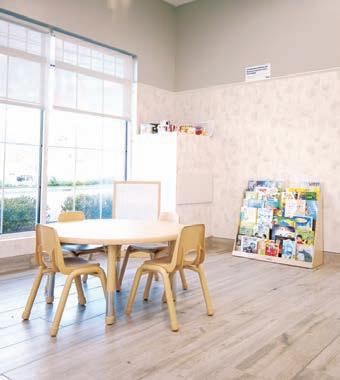
For customers preferring full service, Love Your Laundry provides drop-off WDF for residential and commercial accounts. Each customer’s washing preferences are carefully followed, and laundry is folded by item type and packaged for pickup.
“Our service is simple and efficient,” says DeBarros. “We have a great point-of-sale system that keeps us organized, manages workflow, prints receipts and offers customer communication tools via text.”
In its early months, Love Your Laundry hit “a home run compared to the pro forma,” Balise says of its sales and customer loyalty, adding, “We can’t wait to see where this goes.”
— Haley JorgensenLove Your Laundry, featuring Continental Girbau equipment (A & B), is a high-speed laundry designed to outshine the competition and give back to its community. Its drop-off WDF for residential and commercial accounts is organized through the customer counter (C). The Family Read, Play & Learn literacy space (D) is a popular spot for kids waiting on busy parents. (Photos: Girbau North America)




 by Bruce Beggs, Editorial Director
by Bruce Beggs, Editorial Director
Coin-operated laundry equipment has been the standard for years but the use of digital, cashless payment continues to surge as consumers become more entrenched in its conveniences. But what’s involved in converting a coin-based operation to one whose payment acceptance is based on credit/ debit/store value card or a digital wallet?
Converting to card or mobile payment must involve installing equipment designed to accept the alternate payment form. But what else need be done, from the owner’s perspective?
“The store owner would have made a number of critical decisions regarding the alternative payment method by the time installation of the system commences,” says Wayne Lewis, CEO of ESD Inc., which makes electronic payment systems. “These would have included what system to install, whether it is installed on all or part of the store’s machines, and the setup of any merchant account required.”
“For the store owner, all they need to provide is high-speed internet,” says John Kelly, director of sales for Setomatic Systems’ SpyderWash, which provides card and mobile payment among its options. “This can be through their local internet provider or using a cellular modem. (Setomatic) provides all other required hardware and software needed to interface with the washers/dryers.”
Steve Marcionetti is president of Card Concepts Inc. (CCI), which makes payment products for vended laundries. For a payment conversion to be successful, the store owner should have a plan to market the new system and train staff and customers, he believes.
“Even though most systems today are easy to use, regular customers can sometimes be adverse to change and require a little extra attention,” he says. “Having adequately trained the staff on how the system works will make it much easier for the customers to adapt and utilize the system. Even if you are normally unattended, it would be wise to plan on having someone available during peak periods to provide guidance.”

For KioSoft and its card and mobile payment products, Stacey Cooper, general manager – Retail, says the salesperson or dis-
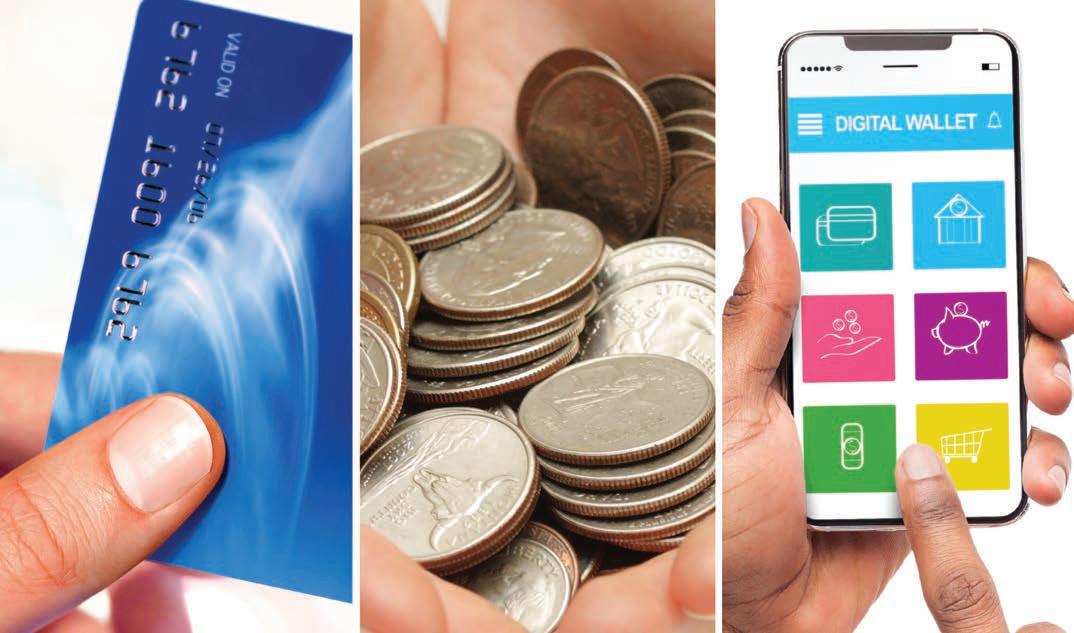



tributor works closely with the laundromat operator to “determine the hardware that is needed based on (their) preference as well as the machine types on-site. Owners should consider what they want to accomplish, how they want to accept payments (laundry card vs. pay at the machine vs. app only vs. combination).”
“Once hardware installation and account setup is complete, the most important step for a store owner to take is to educate their staff and customers on the new solution,” says Steve White, SMB sales manager for PayRange.
“I think the most important aspect of planning is ensuring that the store is adequately staffed for the first couple of weeks after the conversion,” says Oleg Stepanov, business development manager for Mitech Integrated Systems and its Laundroworks card system. “Although Laundroworks is an extremely simple system to use, it is still a change for the customers.”
How long it takes to convert from one payment form to another, or to add a payment option beyond coins, depends on a variety of factors related to the store and to the system being implemented.
“The time it takes for an installation really depends on how many machines are being converted,” Kelly says. “The distributor usually handles the installation of the system, which typically takes one to two days. Another main factor is what day and time the installation takes place, as it’s much faster and easier when (the) store is not busy with customers.”
“Most installations take less than a day and do not require the owner to close the store,” Stepanov says of Laundroworks.
“There are a number of factors that affect the length of time a conversion takes to completion, including the type of system being installed and whether the installation is to be performed while the store remains operational or whether it will be closed during instal lation,” Lewis says. “Many store upgrades are completed in one or two days, provided there are no extenuating circumstances.”
“The administrative onboarding process can take up to two weeks, provided that documents and paperwork are completed promptly,” says Cooper. “As with any aspect of your business, proper planning is essential … A successful conversion to (or addi tion of) payment technology for a laundromat can be accomplished very quickly with knowledgeable guidance.”
“Conversion to an alternative payment system depends on what kind of system is being installed and what make and model machine is being converted,” Marcionetti says. “Some systems can retrofit into the existing coin openings on the machine, others require that holes be drilled into the machine to hold the hardware. If drilling is required, then more time will be required.”
“With PayRange, it is common for store owners to be fully up and running within a week or two of placing their order,” White says. “The PayRange system is (do-it-yourself), self-install easy, with the average store owner able to install the system on all machines in a single day. There is no extensive account setup or other utilities involved.”
A store owner can choose to convert only part of their store, say, a few machines, or go “all in” and convert the entire store at once.
“For a credit card hybrid system, it’s not uncommon for store owners to choose to install devices on only some of the machines, typically the larger machines with higher vend prices,” says
Marcionetti. “This allows the store owner to start offering the convenience to their customers but also limit their initial invest ment. Typically, we find that these store owners will circle back after some time and start converting the rest of the machines in the store as their budget allows.”
Store owners can convert a portion of their store, but the major ity of Setomatic customers prefer to convert the entire store at once, Kelly says.
“This saves them on labor costs and downtime,” he explains. “The thing we always worry about when not converting the entire store is that a customer will come in and all the credit cardequipped washers are being used and now they are forced to use cash. Laundries that convert all their machines typically see a much better ROI.”
“To my knowledge, all of our customers convert their stores entirely and never look back,” Stepanov says. “If you leave a few machines, you still haven’t solved the coin problem fully. Moreover, you have partitioned your store such that neither group has access to the full store.”
“Some people do (convert only a portion), but they almost always come back to order devices for the rest of their store,” says White. “The reason is a partially converted store tends to cause a poor user experience. For instance, if a customer has used the PayRange app on a large washer, but is then required to use quar ters for the dryers, this switching between payment methods at a minimum creates a hassle.”
If only part of the store is to be upgraded, ESD’s Lewis says careful thought should given to the number of machines, machine capacity, and matching dryer availability.
“The risks involved when only part of the store is upgraded include not converting enough machines, not diversifying the washer capacity sufficiently, and not providing the option on the dryers,” he says.
Embracing cashless payment can mean hardware and software changes of varying degrees but a far more basic component has proven just as vital to a successful changeover.
“The significance of user instructional signage cannot be over stated. It is critical to the success and adoption of the new system for all users to know and understand the intricacies of the system’s operation,” Lewis says. “This also includes signage advising the existing customers of the enhancements planned for the store in advance of the system installation. The fewer surprises to the cus tomer database can relate to a smoother acceptance and adoption of the new system.”
“Signage is important, particularly in an unattended location,” says Marcionetti. “Even in an attended location, not every cus tomer wants to be walked through the new product. Some are more comfortable learning on their own, and good signage is key.”
“I would even put (up) a TV with playback of a short clip show ing basic usage,” adds Stepanov.
“Having (signage) posted can help bring more customers into the facility and improve the adoption of the new payment methods with simple instructions,” Cooper says.
“Making a change, such as adding a payment system, is only worthwhile if your customers know about it,” Kelly says.




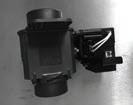
















 by Bruce Beggs, Editorial Director
by Bruce Beggs, Editorial Director
What do you think it would take to enter the commercial linen and uniform rental market? There are streams of potential new revenue available there, yes, but also some new operational challenges and maybe some headaches.
If you run a self-service laundry, starting to service commercial customers might require adding personnel, some type of client management system, more programmable and/or larger-capacity equipment, and more physical space for order storage.
During this summer’s Clean Show in Atlanta, organizers hosted a trio of laundry and drycleaning business owners to discuss the best place to start the transition, how the industry works, and what competition exists, all to help attendees determine if pursuing com mercial laundry customers might be the right move for them.
The panelists were Monika Manter of Balfurd Linen Service in Tipton, Pennsylvania; Kelley Dixon of St. Croix Linen in St. Paul, Minnesota; and Dan Campbell of Wash Around the Clock in Tallahassee, Florida. Each had a unique story to tell.
Manter is a fourth-generation co-owner at the nearly 100-yearold Balfurd, which operates two plants: one for retail dry cleaning and restoration and one for textile rental. The business began as a tailoring shop and had settled nicely into drycleaning work until the 1960s when Manter’s grandfather came across someone selling an at-home drycleaning machine. He feared the trend would put retail cleaners like him out of business.
A friend of his who owned a car dealership had always wanted to rent uniforms, shop towels and the like, so Manter’s grandfa ther bought those products and began renting them to him. A few years later, Balfurd also began renting textiles to restaurant clients but then settled into doing healthcare linens.
“We started with nursing, and at the time, most nursing homes were COG [customer-owned goods], so they own their own prod ucts. They were looking for someone to clean them. So what we did was we took on that COG business at the time and as those products began to wear out, the nursing home didn’t want to buy additional products, so we converted them to textile rental.”
New revenue streams available but operational challenges and headaches may be lurking(Photo: iStock.com/leezsnow)
Balfurd was doing all of its work under one roof, which Manter says was “busting at the seams” in the late ’90s, so it built the 50,000-square-foot plant where it only does textile rental work today.

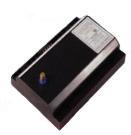


“We have two tunnel washers, four (flat work) ironers, and it accounts for about 90% of our overall revenue of our business,” she says. “So we service three main markets out of that facility.”

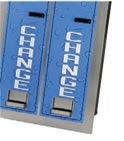

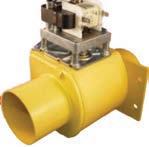


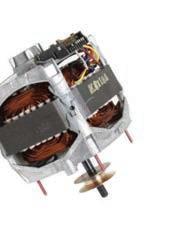





First is food and beverage, e.g. restau rants, bars, bakeries. The main products Balfurd’s customers use are aprons, towels, mats, table linens and cloth napkins. Next is acute healthcare (large hospitals) and retail healthcare (chiropractic offices, outpatient facilities, rehabilitation centers). That prod uct mix is a little different, Manter says, and includes blankets, towels, mats, patient gowns, and isolation gowns.

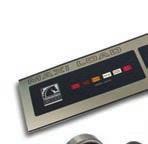

“And then our kind of last division is uni form rental. So that’s for auto body shops. It can be security uniforms, polos, all of that. ... Every one of our customers in that facility is under a contract with us to rent from us for a specified period of time.”
Balfurd’s other facility is for dry cleaning and restoration.
“That facility does do COG. So we’ll do a hair salon, let’s say,

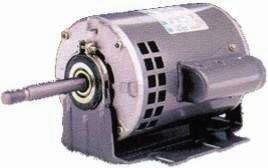

and once their towels are cleaned, we’ll wash/ dry/fold it for them and then deliver it back to them, but we have decided in our textile rental facility, we don’t do any COG what soever.”
The reason behind that decision, she says, is that “it’s really tough to have a ‘mixed’ plant.”
“So, if you have some customers renting and some doing COG, you’re having to keep orders separate for the COG customers, your washers aren’t filled to capacity with rental,” Manter says.

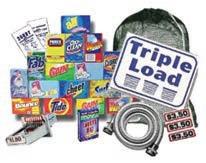
There are some cons to doing textile rental.
“There’s a big upfront cost to buy your products, and especially with the pandemic and the shortages and all of the logistical issues, it’s been harder and harder to get those products,” she explains. “And … you do need a big area to store products, because you have your products in inventory. And as you’re pulling out lower-quality products, you’re having to inject those products into your inventory, so you need some products on hand to do that because you can’t just be constantly purchasing every time you get a new customer.”
Another is that textile rental is more of a commodity business than COG laundry is.

“The competitors in the textile rental market are typically national chains and they will, you know, they drive the price down,” Manter says. “So you have to figure out a way to differentiate, figure out a way to get enough volume that you can be profitable at that lower per-piece price.”



But she says the market is growing, with space for more businesses to come in.


When the mic was passed to Dixon, gener al manager of her linen service company, she admitted that not all that long ago, she was sitting in the audience herself, eager to learn.



“In 2017, I sat in this classroom learn ing how to enter commercial laundry. Five years later, we have a $12 million-a-year, 35,000-square-foot facility.”

Dixon got her first taste of the textile care business in dry cleaning; her father bought a couple of drycleaning businesses in 2001 that he’s since grown to as many as 20 locations. “So I grew up in dry cleaning and went to college, and didn’t think that dry cleaning was the most exciting thing to go into. So I actu ally worked in corporate America for quite a while.



“After five, six years, I came back to my dad and said, ‘You know what, this entrepreneurship thing, I’m really interested, I’d
love to learn more about dry cleaning.’ And at that point, he said, ‘Great, however, I don’t have any positions for you. I’m not gonna kick anybody out, you know, you’re gonna have to figure something out on your own.’”
After speaking to some vendors in the area, Dixon decided there was opportunity for commercial laundry in the Twin Cities. “So, I decided I was gonna get a washer, a dryer, an ironer, and get out there and sell and see what happened.”
Right about then, a local commercial laun dry closed and filed for bankruptcy, leaving Delta Airlines in need of someone to clean its first-class linens, blankets and whatnot.

“They needed someone to do their laun dry, so they flew some representatives up to the Twin Cities and they went to eight differ ent laundries, and we decided to throw our hat in the ring.”
She took the reps to what had been a St. Croix Cleaners facility, about 4,000 square feet, devoid of equipment, empty but still dirty.
“It still had the rails on there and all the dust, and we were showing Delta Airlines, ‘Hey, imagine if you will, we’ll put some washers here and dryers here and we’ll turn it into a laundry for you,’ and they said, ‘Yeah, OK. You start tomorrow.’”
She quickly hired 15 workers from the just-closed laundry. ▼


















“They knew what they needed to do. A couple of them went to the laundromat that my dad owned and overnight were washing Delta blankets. And then we were renting an ironer from another laundry so that we could put the napkins through the ironer for about two months while we were building out this 4,000-squarefoot facility.”
Once it was up and running smoothly, St. Croix Linen start ing getting calls from restaurants and hotels looking to become customers.
“We moved into a 35,000-square-foot facility in May of 2019. Bought a tunnel, a huge ironer and towel folder, and decided we were going to go big with hotels because that was really where the market was. … So right away, we got three hotels that signed on with us and started growing and then COVID hit. At that time, we were operating seven days a week, two shifts, and completely closed the doors for a couple weeks. Repositioned a little bit. Got some healthcare and were able to help out, make it through the pandemic.”
Pivoting to clean food-and-beverage linen also helped, and that market has since become St. Croix’s largest.
“We still service hotels, we have about eight hotels, and we don’t do any healthcare anymore. And we do still have just a little bit of (COG) work that isn’t hotels. We are con tinuing to grow and things are looking much better now that we’ve come out of COVID.”
The 2018 acquisition of another laundry company that primarily did party rental work truly helped St. Croix learn how to be a commercial laundry, she says.
“It was all COG, all real small accounts, and it was a wonderful way to start learning how to get into the business,” Dixon says. “And when you start with COG, there’s no real upfront costs other than the equipment, so if you have a laundromat, you have the equipment already, and as you scale and grow, that’s when you have to get more of the specialty equipment.”
Campbell says he’s a perfect example that you don’t need to know much to get started in commercial laundry.
“I got into this business by throwing mud at the wall to see what stuck, seriously,” he says. “But if you can find a niche in your mar ket, if you’re not looking to scale (large), there are really a lot of (laundry) opportunities that can be very profitable and a very good use of your time and your equipment.”
As Campbell’s number of Wash Around the Clock laundromats grew (he has six now), in 2008, he built out his 6,500-square-foot flagship store and had additional business space next door that he was going to rent to a gym or hair salon.
“I had no aspirations of commercial laundry but this laundromat took off very successfully and I realized pretty quickly I couldn’t sacrifice renting 5,000 square feet to lose parking,” he says.
He watched as personnel from area massage therapists, medical offices and party rental businesses all washed their goods at his laundromat.
“So my distributor and I just basically said, ‘Well, what if we built a commercial laundry in this 5,000 square feet that we have.’ We put in four washers and an ironer, and in the beginning, we didn’t even buy dryers, we just used the laundromat 80-pounders. We rolled the carts back and forth, there was a wall separating (the two sides). And as soon as people heard that we were in the commercial laundry business, they just started calling us.”
His “small boutique commercial laundry,” which he markets as part of his overall business, launders both COG and textile rental. He warns that providing textile rental services is “very costheavy” because you must buy and maintain the textile inventory.
“We had budgeted about $25,000 for inventory, and they grew, they’re actually one of the largest medical marijuana facilities, I think, in North America now. So that $25,000 projection goes to about $125,000 in three months. If you get into the rental business, make sure you’re prepared, even if it’s just a line of credit or some thing, that if you’re going to commit, you’ll be able to keep up.”
Campbell’s commercial laundry service cleans food-and-beverage, hospitality and healthcare linens for various clients. It’s proven popular with his area’s party rental firms, he says.
“To me, that’s easy business for a laun dromat operator if you have a press, because most of those folks aren’t going to make the investment,” he shares.
And depending on the amount of work you’re willing to take on, it can be done with out building a commercial facility.
“If you’ve got quality equipment, and you’ve got good dryers and you’ve got good people that can do the work,” he says. “You know, I look at commercial laundry from a self-serve operator vision as just additional turns per day at my laundromat.
“If you can take your store from four turns a day to seven turns a day as you pick up 30 or 40, even relatively small, commercial clients who have a weekly need, it’s a really good, solid business. And if you get a salon, or you get a massage parlor, all those folks know each other. … If you’re not going to build out a facility, manage your hours. You know when your times are busy and you know when your times are slow and just staff it accordingly.”
One of the best ways to evaluate your market potential is by speaking with businesses in your local community, he suggests.
“Just go talk to them and say, ‘Is this really the best use of your time? Is this really what you want to be doing as a business owner?’ If you find any that say yes, I’ll be shocked. And then you say, ‘How about I take that burden off your plate?’ and that’s how you start.”
Looking back at what he might have done differently as he pursued commercial laundry business, Campbell says he would’ve taken the time to look into training and education.
“I would probably take about a year to invest in some of the train ing courses offered by some of the associations represented here,” he says. “Plant management, how to run a route, how to understand the software … I can tell you that from the beginning, we grew so fast, organization has been a challenge from day one.”
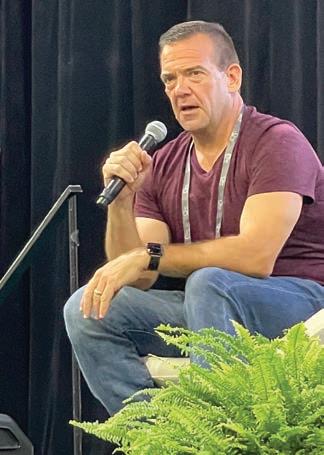
“I’ve seen many great operators post several signs saying, ‘Now Accepting Credit Cards!’ or ‘Now Accepting Apple/Google/ Samsung Pay!’ This is a great way to attract new customers who may be going to a competitor.”
“Yes, particularly with PayRange, signage is key to user adop tion,” says White. “This is because the payment hardware is installed inside the machine, and not visible to the user.”

The management benefits of cashless payment systems are well documented and can, depending on system chosen, include realtime reporting; the ability to start machines or issue refunds remote ly; change vend prices to a penny increment or schedule time-of-day pricing; broad marketing capabilities; and much more.
“The main management benefits of a non-coin payment system are, first and foremost, information and control,” Cooper says. “A payment system provides store owners with much higher levels of information than coins do. Payment systems can inform store owners not only what the most popular cycle selections for their machines are, but when they are happening, and who their best customers are.”
Post-conversion support is critical, says Marcionetti, because as good as technology can be, it can fail like everything else mechani cal in the store.
“Having access to a 24/7 support team with live people on the phone should be standard place with all systems, but store owners







should verify,” he says. “Beyond the live help, access to user manu als, install documentation, and troubleshooting guides should also be easy to access by store owners.”
And take into account the vendor’s history in providing pay ment solutions, he adds: “Making sure the vendor has a long track record will most likely ensure that they will be there for years to come to provide updates and support.”

Whatever company a store owner chooses, it’s important that they have “vast experience in interfacing with all the different brands/makes/models of washers and dryers,” says Kelly.
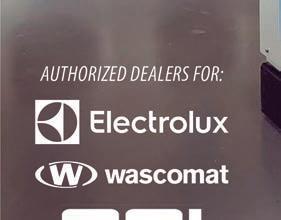




“Post-conversion support and building that trust with your customer is far more important than the initial sale itself,” he says. “Anyone can sell a product, but the support that comes with it afterwards, is what sets a payment company apart from their competition.”
“Once customers experience the efficiency of conducting trans actions on their phone, they actually do more laundry than with coin-only machines,” says White. “Conventional thinking has been that people only have so much laundry to do, but the way they do it changes when there is no payment barrier. Customers are no longer bound to the amount of coins in their pocket.”
Stepanov recommends visiting stores with alternate payment systems to get the full experience before making a decision about converting from coin.
“It’s transformative, especially if you completely replace the coin drops,” he says. “We’ve had customers report that the conversion has changed their life.”
RJ Kool, a commercial laundry distributor headquartered in Kansas City, reports that it has purchased Minnesota-based dis tributor BDS Laundry. Terms of the acquisition were not disclosed.
The sale of BDS includes its vended and on-premises laundry equipment businesses, as well as its online parts and service busi nesses. BDS Laundry Management, a provider of route laundry services and equipment sales to multi-housing customers, is not included in the acquisition.
RJ Kool’s purchase of the fellow distributor expands its leader ship position as “the largest and most experienced commercial laundry distributor in the Midwest,” the company says.
In addition to its existing sales and service operations in Missouri, Nebraska and Oklahoma, the company will begin serv ing customers in additional markets that include Minnesota, North Dakota, South Dakota, Wisconsin, Iowa, Illinois, and the Upper Peninsula of Michigan.
“The purchase of BDS represents a major milestone in our company’s strategy to become the premier commercial laundry distributor in the United States,” says Bill Kimmel, who, along with Darren Harding, owns RJ Kool. “We are thrilled to expand our footprint and accelerate our growth.”
BDS employees are being retained, and the company will be rebranded as RJ Kool in the coming months. David DeMarsh, the second-generation owner of BDS, will remain active in the business and serve as a consultant during the transition.

“Customers can rest assured knowing their existing relationships with BDS sales and service representatives will continue uninter rupted,” says DeMarsh. “I am confident in RJ Kool’s leadership team and look forward to supporting the company during the transition.”
CleanCloud, the all-in-one point-of-sale (POS) software, reports that it now integrates directly with the software utilized by local commerce platform and on-demand delivery service DoorDash.
This integration enables laundromats and dry cleaners to launch or expand their pickup and delivery (PU/D) in short order with no upfront cost, CleanCloud says.
The launch and operation of a PU/D fleet can be costly for laun dromat and drycleaning businesses to adopt, it continues. With the new on-demand integration, customers can launch their own service, leveraging DoorDash Drive’s white-label fulfillment capa bilities, in as little as 24 hours.
Laundry owners can focus on growing and expanding their cleaning operations while pickup and delivery are handled by DoorDash Dashers.
Laundries offering pickup and delivery through the integration can provide customers with customizable time slots for same-day PU/D, scale service during busy periods and cut back when it’s quiet, and test new routes to expand their reach, CleanCloud says.
Continental Creative Services (CCS), a division of Girbau North America (GNA), recently changed its name to Girbau Creative Services (GCS).
“We wanted to change the name to better align with our par ent company, Girbau Global Laundry Solutions,” says Creative Services Manager Kim Foxcroft.
Developed in 2005 to support GNA distributors and end-users, GCS offers cost-effective marketing, advertising and public rela tions services. With a team of laundry industry marketing experts, GCS provides distributors and their customers with everything from logo, brochure and website development to signage, direct mail campaigns, vehicle wraps and press releases, according to Foxcroft.
“We’ve worked closely with distributors and store owners for years to provide the kind of marketing support that sets them apart in the eyes of their customers,” she says. “We move forward together under the Girbau umbrella — focused on customer prox imity, one team, and innovation and sustainability.”
Luis Bello, route collector at Aaxon Laundry Systems, Ft. Lauderdale, Florida, recently celebrated 25 years of service with the company.
Bello joined Aaxon in 1997 and is highly rated in the organization for his techni cal knowledge, loyalty, dedication and hard work, the company says.
“It has been a great journey at Aaxon Laundry Systems, and it is hard to believe that I have already spent 25 years here,” says Bello. “I have enjoyed each day in this amazing organization and am grateful to all my past and current colleagues and the management for making it such a wonderful workplace.”
“I have worked with Luis Bello since the day I joined the com pany as an area manager,” says Lori Maron, Aaxon’s operations manager. “A very knowledgeable technician, he taught me a lot about the machines when I started and was very patient with me when teaching.”
Bello is extremely knowledgeable and passionate about Aaxon, Maron adds, and truly cares about his co-workers and customers.
“No wonder all our customers know him by name,” she says. “It is always a pleasure working with Luis. I congratulate him on the completion of 25 years in the company and hope he will be around for many more years to come.”
Commercial laundry and drycleaning equipment distributor EVI Industries, Miami, has acquired Southside, Alabama-based Wholesale Commercial Laundry Equipment SE (WCL). Terms of the deal weren’t announced.
WCL distributes commercial laundry products and provides related technical installation and maintenance services to onpremise and vended laundry customers. With the acquisition, EVI says it adds an experienced sales team with established customer relationships and a service team with a longstanding reputation for providing reliable services.
The deal makes WCL the 23rd commercial laundry business to be acquired by EVI since fall 2016.
Henry M. Nahmad, EVI’s chairman and CEO, says each acquisi tion is integral to achieving his company’s long-term growth and profitability goals.
“The addition of WCL expands our geographic footprint in the Southeast region of the United States, where we will have a sig nificant opportunity to deliver commercial laundry customers an enhanced customer-value proposition,” he says. “We look forward to working with Russ Arbuckle and the WCL team to grow our market share across the Southeast.”
WCL will operate as an EVI subsidiary under its current name, from its present location, and backed by EVI resources as it pursues the corporate long-term growth strategy.

EVI says it is the fastest growing and only publicly listed com pany devoted to the North American commercial laundry distribu tion and service industry.
Thoughtful execution of its buy-and-build growth strategy has earned it a positive reputation in and around the industry, Nahmad says, including among owners of quality businesses.
“We remain very active in the pursuit of additional investments in other great businesses and given our record, reputation and appetite for significant growth, EVI is well-positioned to capitalize on a growing number of opportunities,” he adds.
Whirlpool Corporation has been named to Forbes magazine’s 2022 list of the “World’s Best Employers,” the maker of commercial laundry equipment and other equipment types reports.

The list includes companies worldwide and acknowledges each
company’s dedication to make every individual feel at home within the four walls of the business.
“The talent of our employees brings our products to life through innovation, diverse ideas, and a focus on continuous improve ment,” says Carey Martin, Whirlpool’s chief human resources officer. “We’re honored that Forbes has named Whirlpool to its World’s Best Employers list once again in 2022, and proud that our employees can feel part of a larger global family touching the everyday lives of consumers, making those lives a bit easier, a little bit better and a little bit brighter.”
For nearly 111 years, Whirlpool has taken meaningful actions to cultivate a strong, inclusive and diverse culture to support its employees around the world, the company says. It has Employee Resource Groups (ERGs) for underrepresented groups in North America, Europe, Middle East, Africa, Latin America and Asia. The formation of those groups reaches back as far as 1998, with the office for Diversity and Inclusion created a few years later in 2001. The company has also launched several important initiatives to support employee education and advancement, including profes sional development training and its annual Global Inclusion Week.
Earlier this year, the Coin Laundry Association (CLA) presented its 2022 Industry Awards, honoring men and women who’ve contrib uted to the Association and helped to further the laundry industry. This year’s honorees were:





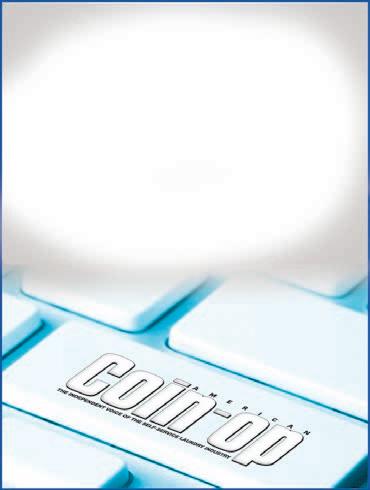








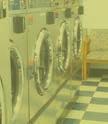

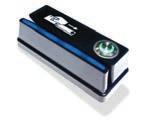
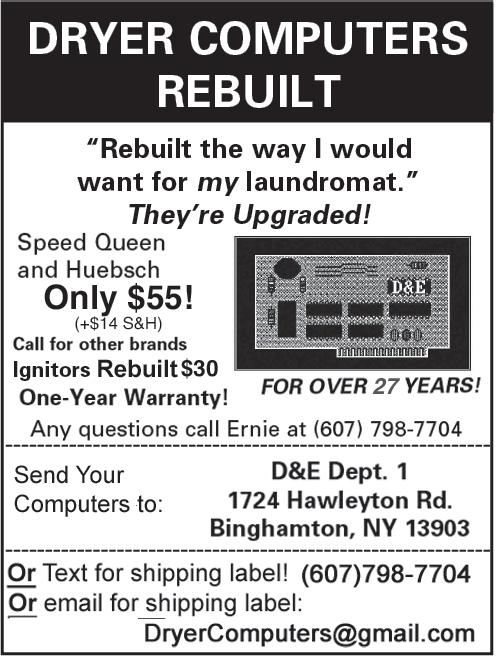










CLA says this award is its highest honor, recognizing lifetime contributions to the laundry industry.
The Williford family owns and operates The Wash House, a chain of over 30 laundromats serving communities in central, east ern and southern North Carolina. Brothers Lee and Luke Williford operate the third-generation business, with some stores operated by brothers-in-law. Lee’s and Luke’s grandfather began the business in 1965, and their father, Marshall Williford Jr., purchased it in the mid-1970s.
Williford Jr. served as CLA chair in the late 1990s. He was an ambassador of emerging best practices for laundromat operation and participated in speaking engagements on behalf of CLA in addition to board volunteer responsibilities.
Lee and Luke Williford have followed in their grandfather’s and father’s footsteps by further modernizing The Wash House brand, embracing technology, and developing human resources, while volunteering and sharing with industry peers, CLA says.
Unema, who owns Brio Laundry in Bellingham, Washington, is lauded as CLA Member of the Year for outstanding work to both move the industry forward and her efforts to support fellow CLA members. She has served as a volunteer, contributed to the CLA publication, served as panelist for educational webinars, and more.
Named in honor of former CLA Communications Director Dick Torp, Diaz earned the Excellence in Education award by dis tinguishing himself through his efforts to educate the laundromat industry in digital marketing best practices, regularly authoring articles, serving as speaker and panelist, and advising CLA staff.
The honor recognizes Milch and Weiss for their initiative and efforts to rally industry partners in lobbying for laundromats to be included in the Federal guidance for essential businesses during the COVID-19 pandemic. Both men committed funding and used their networks and influence to work in partnership with CLA and an ad hoc group of industry members, the Association says.
This award is presented to a member of the CLA Board of Directors who has contributed an extraordinary effort and “gone the extra mile” in service on the CLA Board, the Association says. Maes’ peers recognized him for his passion, effort, and leadership exhibited during his service as treasurer, nominating committee chair, and other committee and task force roles.
The Chairman’s Award recognizes those who’ve served as CLA board chairpersons. Daryl Johnson and Kathryn Rowen served in 2021, and Brian Grell served in 2020.
Distinguished Service Awards were presented to the following CLA board members who retired between 2019 and 2021: Russ Arbuckle, Ken Barrett, Brian Brunckhorst, Joel Jorgensen, Ron Kelley, Steve Marcionetti, John Olsen, Charlie Pasquale, Peggy Trent and Lisa White.
$7 MILLION IN SEED
Smart laundry technology platform Tumble, based in San Francisco, reports it has raised $7 million in seed funding to “modernize the shared laundry experience and transform out dated machines into revenue-generating assets.”
Funding will be used to scale its proprietary software platform— powering an all-digital experience from cashless payment to cycle tracking and machine security—to serve rental properties and residents nationwide, and soon consumers with a new pickup-anddelivery (PU/D) service, according to Tumble.
It looks to tap into the growing gig economy once it debuts the new PU/D service. The offering will further expand platform capa bilities and value for Tumble customers, and give consumers the opportunity to earn using their existing laundry rooms.
“Our new pickup-and-delivery service provides a way for people to earn money using an existing amenity in their apartment build ing while tapping into pent-up demand for gig economy workers that may not have, or may not want to drive their car in order to earn extra money,” says Bob Wall, Tumble CTO and former founder of Washio.
The funding round was led by Hivers and Strivers and included participation from Array Ventures, Western Technology Investment (WTI), the PenFed Foundation, Zag Capital, as well as angel inves tors, including Richard Dalzell, former AWS senior vice president and current board member at Twilio and Intuit, and early Groupon investor Rich Heise. Tumble also secured $1.5 million in venture debt from WTI.
Tech-enabled laundry pickup and delivery service HappyNest is continuing to expand, the company reports, announcing that its service is now available in new locations in Texas, New Jersey, Illinois, California and South Carolina.
HappyNest is available in Georgetown, Texas, located 30 miles north of Austin, via new partner U Wash M Laundromat. Jared Story has owned and operated his business since 2012 and is adding HappyNest pickup and delivery service to U Wash M’s 2,960-square-foot facility. It’s equipped with 20 extractor washers, 20 top-load washers and 30 dryers.
In Middlesex County, New Jersey, HappyNest service is now available via new partner Sudz N Dripz Laundromat in North Brunswick. Owners Bill Van Jura and John Weir have been in the laundromat industry for over 25 years. Their 2,500-square-foot facility is equipped with 74 washers and dryers.
HappyNest has expanded service availability to Chicago sub urb Crystal Lake, Illinois, via new partner Kimberly’s TLC. Its 1,800-square-foot facility on Terra Cotta Avenue houses 33 wash ers and 44 dryers.
Elite Laundry Center, Tujunga, California, has brought HappyNest service to its area and parts of Pasadena. The 2,100-square-foot facility on Foothill Boulevard in Tujunga is equipped with 29 washers and 14 stack dryers.
HappyNest has expanded availability to Myrtle Beach, South Carolina, via new partner Sam’s Laundromat, based in Conway. The 2,200-square-foot location on Wright Boulevard is outfitted with 28 washers and 30 dryers.


